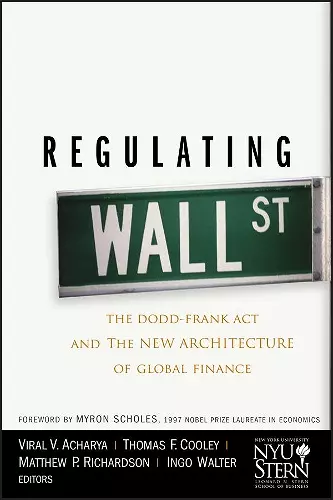Regulating Wall Street
The Dodd-Frank Act and the New Architecture of Global Finance
New York University Stern School of Business author Ingo Walter editor Viral V Acharya editor Thomas F Cooley editor Matthew P Richardson editor
Format:Hardback
Publisher:John Wiley & Sons Inc
Published:19th Nov '10
Currently unavailable, and unfortunately no date known when it will be back

Experts from NYU Stern School of Business analyze new financial regulations and what they mean for the economy
The NYU Stern School of Business is one of the top business schools in the world thanks to the leading academics, researchers, and provocative thinkers who call it home. In Regulating Wall Street: The New Architecture of Global Finance, an impressive group of the Stern school’s top authorities on finance combine their expertise in capital markets, risk management, banking, and derivatives to assess the strengths and weaknesses of new regulations in response to the recent global financial crisis.
- Summarizes key issues that regulatory reform should address
- Evaluates the key components of regulatory reform
- Provides analysis of how the reforms will affect financial firms and markets, as well as the real economy
The U.S. Congress is on track to complete the most significant changes in financial regulation since the 1930s. Regulating Wall Street: The New Architecture of Global Finance discusses the impact these news laws will have on the U.S. and global financial architecture.
"A fascinating, lively, and thoroughly readable guide to the Dodd-Frank Act that pierces the cloud of confusion that hangs over so much of the financial reform debate. It is extremely timely and valuable, and should be required reading for all policymakers, investors, and students of finance. What makes the book so valuable is that it not only analyzes the scope of the Act, in a punchy, lively style, but it also discusses its potential impact. More important, the book analyzes what is not covered in the Act—and where the potential challenges to the financial system still lie."
—Gillian Tett, U.S. Managing Editor, Financial Times
"The crisis of 2008 confronted even well-educated Americans with a flood of incomprehensible financial vocabulary, describing novel financial institutions and practices most of us had never heard of before. Now we have the 2,300-page Dodd-Frank Act, designed to provide the needed repair. Will it do so? What else will it do? How can we even start to think about these basic questions? Regulating Wall Street addresses these questions in a clear, direct style, taking us through the many parts of the Act one at a time, and providing informed, cogent economic analysis of each. A valuable standard source for future discussion."
—Robert E. Lucas, University of Chicago, 1995 Nobel Laureate
"Take the faculty of one of the best finance departments in the world. Ask them to analyze the new U.S. legislation on financial regulation, and to think about what the new law gets right, what it gets wrong, and how it is likely to shape the future of the financial system. With a bit of luck, you get this very impressive book. An absolute must-read."
—Olivier Blanchard, Chief Economist, International Monetary Fund
"Regulating Wall Street goes a long way toward clarifying the intent of the various provisions of the Dodd-Frank Act and evaluating both its effectiveness and limitations. The need for effective implementation by agencies is appropriately emphasized. Not a quick read, a useful reference work on an enormously complex piece of legislation, dealing with an even more complex financial reality."
—Paul Volcker, Chairman of the Economic Recovery Advisory Board and former Chairman of the Federal Reserve (1979–1987)
“There are many villains in the story of the recent crisis and much written to name them, describe them and even curse them. . . If you want to know how to fix the problem, I highly recommend ‘Regulating Wall Street,’ from New York University’s Stern School of Business. . . In the excellent book, ‘Regulating Wall Street,’ several of the studies indicate that there are few synergies among financial activities that could lead to economies of scope. The studies also demonstrate that multiple functions in large, complex firms can actually increase systemic risk. Moreover, they suggest that the spun-off activities could thrive without explicit or implied government support. The conclusion in this book is that separating activities in this manner, together with stronger resolution processes and better capital standards, would do much to strengthen our financial system, making it more accountable and stronger.”
—Thomas M. Hoenig, President, Federal Reserve Bank of Kansas City
"Readers should read Regulating Wall Street to understand why, in the face of market failures and copious evidence that Wall Street is unproductive, Congress and regulators labored mightily to resurrect the financial intermediation racket just as it existed on September 12, 2008." (Tax Notes)
“If you want to know how to fix the problem, I highly recommend Regulating Wall Street, from New York University’s Stern School of Business.”
—Karl Denninger, Seeking Alpha
“One refreshing sign of hope for constructive change is that economists, some of whose theories had much to do with a light regulatory approach toward derivatives and the housing bubble, are increasingly producing research calling for stricter guidelines then Dodd-Frank or the Obama administration. Regulating Wall Street presents a wide range of new research supporting stronger regulations than Dodd-Frank recommends, such as . . . tax proposals. . . In the prologue of Regulating WallStreet, the editors, hardly known as progressives, remind financiers how useful strong regulations were in the past. . . We would be better off if the powers on Wall Street would remember. . . “
(New York Review)
- Winner of R.R. Hawkins Award - Business, Finance & Management 2011 (United States)
ISBN: 9780470768778
Dimensions: 236mm x 163mm x 47mm
Weight: 844g
592 pages